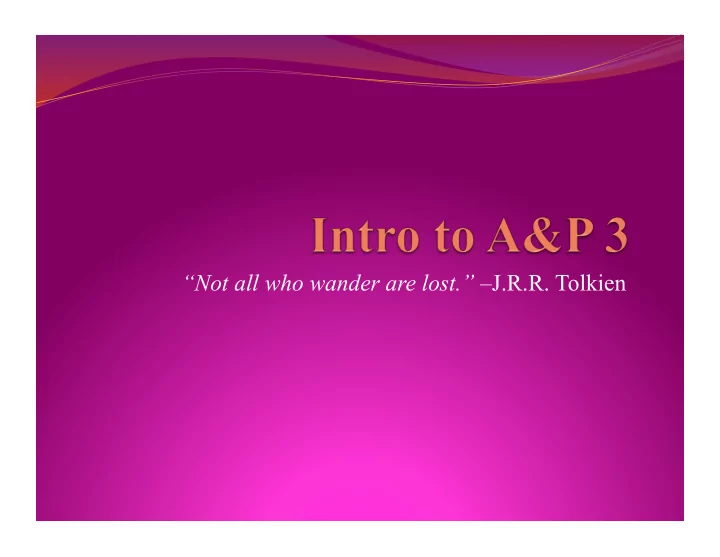

“Not all who wander are lost.” –J.R.R. Tolkien
Lesson Plan: Intro to A&P 3 Attendance and Breath of Arrival Intro to A&P 3
Homeostasis Homeostasis Constancy of the body's internal environment. It represents a relatively stable condition within a very limited range. Example: when we get too cold our muscles spasm (shivering) to warm us.
Membranes Membrane Soft pliable sheets of tissue that cover the body, line tubes or body cavities, cover organs, and separate one part of a cavity from another.
Membranes Cutaneous membrane (AKA: skin) Epithelial membrane that covers the entire surface of the body .
Membranes Mucous membrane (AKA: mucosa) Epithelial membrane that lines openings to the outside of the body. Example: nasal membrane.
Membranes Serous membrane Epithelial membrane that lines closed body cavities that do not open to the outside of the body. Example: pericardium.
Membranes Synovial membrane Connective tissue membrane that lines cavities of freely moving joints.
Fill in the Blanks 1. membrane = covers the external body surface. 2. membrane = lines openings to the outside of the body 3. membrane = lines body cavities. 4. membrane = freely moving joints.
Fill in the Blanks 1. Cutaneous membrane = covers the external body surface. 2. Mucous membrane = lines openings to the outside of the body 3. Serous membrane = lines body cavities. 4. Synovial membrane = freely moving joints.
Anatomic Position Anatomic position Standard body position used in Western medicine. The body is upright and facing forward, arms at the sides, palms facing forward , thumbs to the side, feet are about hip distance apart, with toes pointing forward.
Plane Midsagittal / Median Plane Sagittal Plane Frontal / Coronal Plane Transverse / Horizontal Plane
Planes of References Plane A flat surface determined by three points in space such as height, depth, and width.
Planes of References Midsagittal/Median plane Plane that runs longitudinally or vertically down the body, anterior to posterior, dividing the body into equal right and left sections.
Planes of References Sagittal plane Plane that passes through the body parallel to the midsagittal plane.
Planes of References Frontal/Coronal Plane Plane that passes through the body side to side, creating anterior and posterior sections.
Planes of References Transverse/Horizontal plane Plane that passes through the body to create superior and inferior sections.
Directional Terms Superior (AKA: cranial or cephalic) Situated above or toward the head end. Inferior (AKA: caudal) Situated below or towards the tail end.
Directional Terms Anterior (AKA: ventral) Pertaining to the front side of a structure. Posterior (AKA: dorsal) Pertaining to the back of a structure.
Body Cavities Medial Oriented toward or near the midline of the body. Lateral Oriented farther away from the midline of the body.
Directional Terms Ipsilateral (AKA: homolateral) Related to the same side of the body. Contralateral Related to opposite sides of the body.
Directional Terms Proximal Nearer to the point of reference. Extremities only. Distal Farther from the point of reference. Extremities only.
Directional Terms Deep (AKA: central) Pertaining to or situated at the center of the body. Superficial (AKA: peripheral) Pertaining to the outside surface, periphery, or surrounding the external area of a structure.
Response Moment
“Not all who wander are lost.” –J.R.R. Tolkien
Recommend
More recommend